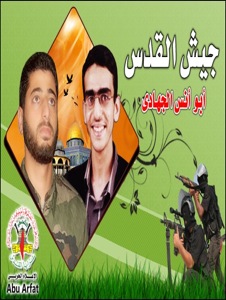
While participating in jihad gives a jihadist important religious credibility, death in battle provides immortality, as the deceased is ranked a martyr. It is believed that Muslim martyrs will be highly rewarded in the afterlife for their sacrifice and hold a special position in heavenly paradise. It is therefore not surprising that martyrdom is a central theme in jihadi visual propaganda.
The figures in this specific image are identified as Hamza Salim Abu Tuyur and Mahmud Fayiq Abu al-Haj, both deceased members of the Shqaqi faction of Palestinian Islamic Jihad (PIJ). The caption on the top right reads: “jaysh al-quds” (“al-Quds [Jerusalem] army [i.e., PIJ]”). Underneath appears the name Abu Anas al-Jihadi, an active member and administrator of the Palestinian web forum al7orya.net (‘ushshaq al-hur), whose images are widely cited and reproduced. He holds the rank of “faris al-sawtiyyat” (“audio [clips] administrator”/ lit. “leader, cavalier or hero”) (cf. http://www.saraya.ps/forum/showthread.php?t=30712). At the bottom of the PIJ logo appears an added line that reads: “al-i‘lam al-harbi” (“military/combative media”) and the likely name of the image’s creator Abu Arafat.
The logo contains a number of elements that are part of the jihadi visual propaganda repertoire, including the Dome of the Rock. While Muslims across sectarian lines share a reverence for many holy sites, some sites hold special significance for certain groups. For instance, the Dome of the Rock is recognized and revered by all Muslims, as it was built in 692 A.D. by the Umayyid caliph ‘Abd al-Malik on the site where Muslims believe the Prophet Muhammad ascended to heaven in his mi‘raj (night journey). Indeed, it is considered the third holiest site in Islam after Mecca and al-Madina. At the same time, the Dome of the Rock is a powerful symbol of Palestinian nationhood.
More Information
Finally, the image features doves in between the two figures. The world of birds in general is very important in the symbolic language of Islam. Pre-Islamic Arabs imagined soul birds fluttering around the grave of the deceased, and the bird continues to symbolize the flight of the soul beyond the confines of this world. Doves in particular are considered sacred, since they are believed to have protected Muhammad during his nocturnal journey. It is in this manner that the dove can be linked to the notion of martyrdom and the rise of a martyr’s soul to heaven. The dove is also a symbol of loving fidelity, which is manifested by the collar of dark feathers around its neck, called “the dove’s necklace.”
 Skip to content
Skip to content
